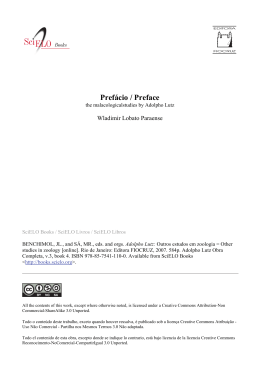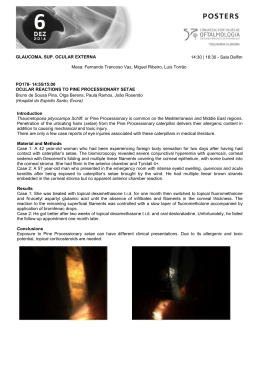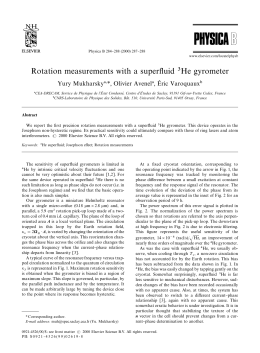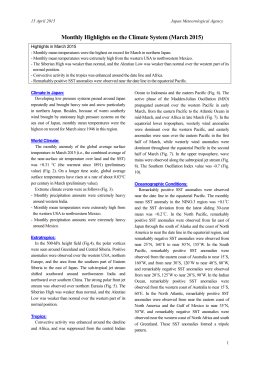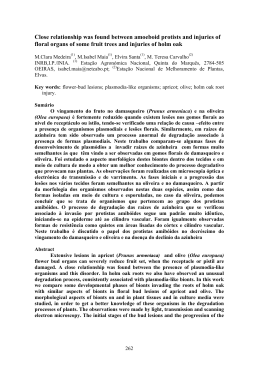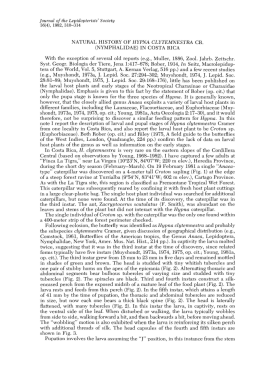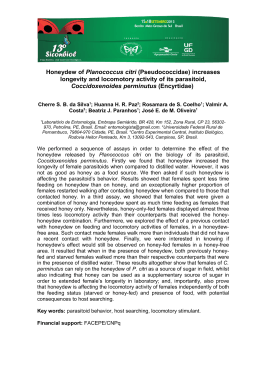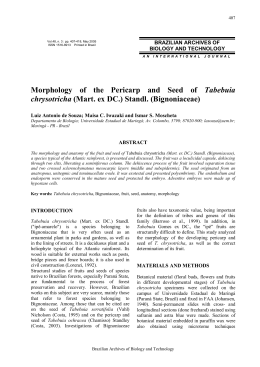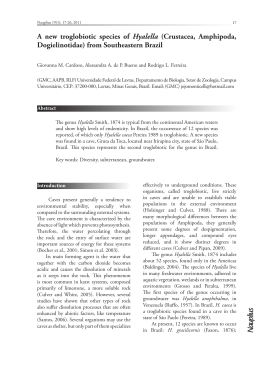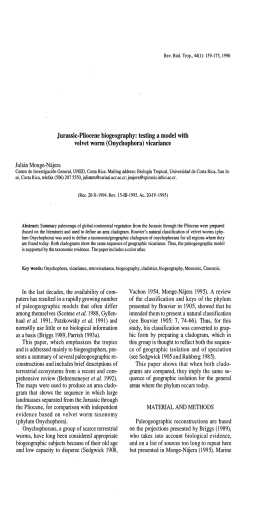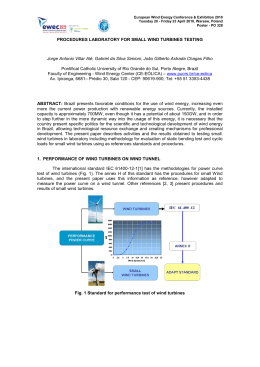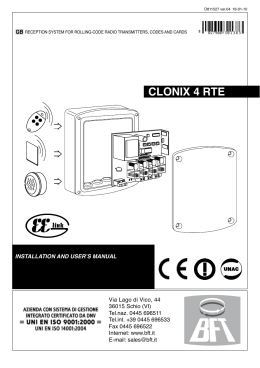(Reprinted from the Proceedings of the Entomological Vol. 47, No. 9, December, NOTE ON HA.EMAGOGUS Society of Washington 1945.) CAPRICORN11 Culicidae)’ LUTZ, 1904 (Diptera, By N. L. CERQUEIRA, Laboratdrio do Service de Ctudos e Pe_rqui_raJ rSbre a Febre Amartla, Rio de Janeiro, and JOHN LANE, Institute de Higiene da Universidade de Go Paula Because of the role of HaeGzogogus as forest transmitters of yellow fever virus it is desirable that the exact taxonomy of different members of the genus be described accurately. It is the purpose of this paper to establish definitely the taxonomic characteristics of both males and females, as well as the developmental stages, of Haemagogur capricornii. The material upon whieh these descriptions are based is derived from females captured in the capricornii type area, in Horto Florestal, Serra da Cantareira, near the city of %o Paula, Brazil. The original description of Haemagogus caprzcornii by Lutz was based upon female specimens only. Heretofore no males or larvae stemming from females of the type area have been described. B ef ore discussing our material we wish to refer to the literature bearing upon the taxonomy of this mosquito and reproduce the description given by Lutz. In 1904, Lutz (in Bourroul’s thesis) gave a short description, and in 1905 a more detailed one, of female mosquitoes to which he gave the species name of capricornii. The type locality is the Horto Florestal da Serra da Cantareira, near the city of SZO Paulo. Dyar (1928) considered this species as a synonym In 1939, Antunes revalidated H. capricornii of H. equinur. and made H. janthinomys a synonym of it. Cerqueira (1943) described the female’ from Bolivia and male genitalia from Brazilian material which had been compared with specimens from the State of Sao Paulo but not from the type locality. We wish to add that in our opinion the detailed description given by Lutz in 1905, in which he placed the species in a new genus and added the words “nov. spec.” instead of “Lutz (in Bourroul’s thesis)“, does not invalidate his original description. Haemagogus (Haemagogus) capricornii Lutz, in Bourroul, 1904 1904Hacmagogus capricornii Lutz in Bourroul, Mosq. do Braz. 66:4, Catal. 13. 1% S7e~oconops capricorni Lutz, Imp. Medica, 13 (S), 83-84. . We herewith quote from Lutz’s original description: 1The studies and observations on which this paper is based were conducted with the support and under the auspices of the “Service de Estudos e Pesquisas s8bre a Febre Amarela” of the Ministry of Education and Health of Brazil in cooperation with the International Health Division of The Rockefeller Foundation, and the Instituto de Higiene of the University of SBo Paulo. ’ 280 PROC. ENT. SOC. WASH., VOL. 47, NO. 9, DEC., 1945 . X STEGOCONOPS CAPRICORNI Nov. gen. nov. spec. (pg. 83-84) (F&mea). Comprimento do corpo 5 mm., sem a tromba que mede 2.5 mm. Car geral axul metallic0 escura, sendo o fundo desnudado preto. Tromba-Comprida, preta, corn brilho escuro, quasi do comprimento do abdomen; OS labellos amarellos na ponta, onde ha pellos finos e alguns urn pouco maiores no lado inferior da raiz. Antennas-Quasi do mesmo tamanho que a tromba, Torus muito escuro, quasipreto mas corn brilho esbranquisado e corn pellos curtos e escuros do lado interno; no flagello tanto OSpellos maiores coma OS menores sgo de c6r preta, porem OSultimos corn brilho prateado. PalposrPretos, corn brilho azul e muitos pellos escuros. . Clypeus-Como OStorus das antennas. * Occiput-Fundo preto; na margem posterior dos olhos uma fileira de pequenas escamas brancas, espatuladas; o resto 6 coberto de escamas maiores, chatas e imbricadas, de c8r azul metallico; estas, coma tambem as do prothorax, pleuras, mesonotum, abdomen e extremidades, ~5.0 espatuladas corn a ponta mais ou menos arredondada; pelo lado de fora e na regigo mental Go substituidas por escamas branco-nacaradas. . Lobulos prothoracicos- Muito salientes, corn pellos escuros e escamas, iguaes em forma, c&r e agrupamento 5s do occiput. Mesonotum-CBr preta, escamas obovais iridescentes em Verde-azul, bronze e cobre, coma pennas de beija-flor. As mesmas urn pouco alongadas, encontram-se no scutellum. Pleuras-Esca,mas branco-nacaradas, formando uma mancha continua, de brilho branco urn pouco prateado. Scutellum-Nos lobes lateraes 3 para 4 pellos maiores, no medio 2 para 4. ‘Acima da raiz das azas ha pellos grossos, escuros em numero maior, que seguem s8bre a margem do scutellum, onde existem nos lobos lateraes e no mediano, . em numero variavel, coma vimos, por serem em parte substituidos por outros mais curtos. Abdomen-Em cima de cijr uniforme, azul metallic0 escuro, havendo apenas na base dos ultimossegmentos algumas. escamas brancas; estas tambem se acham na face ventral, onde cobrem de modo uniforme OSprimeiros segmentos, e formam manchas obliquas no lado dos ultimos; a conformasao dos tres ultimos segmentos segue o typo do genero Carrollia e Gualteria. Azas-Escamas medianas espatuladas, curtas e largas, corn brilho metallic0 e outras de c&r cinzenta, compridas e estreitas, do typo. do g&rero CuZex;cellulas forqueadas pequenas, menores do que OS seus pedunculos; a primeira mais es_ treita que a segunda; as duas primeiras nervuras transversaes formam um angulo obtuso, aberto para a base, da qua1 a terceira se approxima por ma& do seu comprimento. Pernas-De azul escuro uniforme, corn excep&o do aspect0 inferior do femur posterior, que 6 coberto de escamas nacaradas; ha muitos espinhos principal_ mente no lado inferior das tibias posteriores, onde s80 visiveis macroscopica_ l mente. Unhas das patas anteriores, iguaes, maiores e corn dente na base; as das pas_ teriores, diminutas, iguaes e inermes. PROC. ENT. SOC. WASH., VOL. 41 PLATE 32 Huemagogus capricornii Lutz, 1904, Fig. 1 and la: Fifth tarsal segment and claws of fore- and mid-legs of the male. Fig. 2: Male genitalia; sidepiece and claspette? ventral view, WI 282 PROC. ENT. SOC. WASH., VOL. 47, NO. 9, DEC., 1945 NOTA: Esta especie sylvestre predomina na zona atravessada pelo tropic0 de Capricornio, do que o nome generic0 6 derivado. Nao conheso o Haemagogus cyaneur, mas pela descri@o trata-se de urn mosquito semelhante, conquanto differente no genera e na especie. Desconheso o-macho, mas OScaracteres da femea indicam que deve ser collocado ao lado de Stegoconopsleucomelar. ’ DESCRIPTION OF OUR MATERIAL The material herein described was derived from females captured in the cap&or&i type locality during the month of April 1944. In all, 13 females were captured, nine of which deposited eggs. From these eggs 136 larvae were hatched, and 46 males and 55 females eventually developed. Thirty examples of each sex, together with the larval and pupal skins, were selected for study. It is of some interest to note that considerable ‘difficulty was encountered in obtaining eclosion of the eggs. Indeed, eight months and seven or more immersions alternating with periods of desiccation were required to obtain maximum eclosion. Female.-Head. Proboscis blue-black, long, slender, about one-fifth the length of the forefemur. Palpi of the same color as the proboscis and slightly longer than the clypeus; clypeus and torus shining black. Antennae testaceous. Occiput with broad truncated, adherent scales of a metallic blue color with greenish reflections; eye margins with scales which are arranged in a narrow line that does not reach the vertex when seen from above and which form a patch in the region of the mentum; margin of the eyes and vertex with black setae. Thorax. Pronotal lobe prominent, nearly united on top, covered with scales of the same color as those of the occiput but in which the green reflection is stronger; many black setae on top and on the anterior margin. Mesonotum with broad, flat ovate scales intermixed with narrow ones, greenish-blue with coppery reflection in the center and blue over the base of the wings in the prescutellar region and the scutellum; the scales in those areas are longer and broader than in the center of the mesonotum; black setae present on the anterior margin, between the pronotal lobes, behind the base of wings and on the posterior margin of scutellum. Posterior pronotum with scales of the same color as those of the mesonotum, the other sclerites and coxae covered with white scales; sternopleuron with two setae. Abdomen covered with dark metallic blue scales, except for a lateral continuous area of white ones from the first to the fifth tergite and basolateral oblique spots on the sixth and seventh, there being, in some specimens, one or two dorsal white scales on these tergites; venter with basal white bands except on the last segment. Legs dark metallic blue; fore- and midfemora with internal patches of white scales on basal two-thirds; hindfemur with this patch occupying the basal fourfifths. Fore- and midtarsal claws toothed, the hind ones simple. Wings with metallic blue scales. Male.-Coloration as in the female. Antennae densely plumose, ahout twothirds the length of the proboscis. Palpi about twice the length of clypeus. Ab- PROi ENT. SOC. WASH., VOL. PtATE 33 41 6 Huemugogus cupricornii Lutz, 1904. Male genitalia. Fig. 3: Claspette, lateral view. Fig. 4: Distal half of the tenth sternite. Fig. 5: Ninth tergite. Fig. 6 and 6a: Mesosome; dorso-ventral and lateral view. Fig. 6b. Eighth tergite. P331 . . 284 PROC. ENT. SOC. WASH., VOL. 47, NO. 9, DEC., 1945 domi-nal markings which are restricted to the three basal tergites, the others having white spots. Legs with a stronger violet dark-blue reflection. Foreand mid-tarsal claws (Fig. 1 and la) large, toothed, the hind ones small and simple. Genitalia (Fig. 2) : Side-piece slightly over three times the basal width, lateral margin with long setae and scales, inner margin with long lanceolate scales interspersed with three sizes of broad pointed ones; basal lobe small, reduced, with many long, narrow setae. Clasper short, one-third the length of the side-piece, enlarged at the middle, striated but nude; apical appendicle long, strong, blunt, .about half the length of clasper. Claspette (Fig. 3) low; stem curved, moderately short and pilose, with two setae which are somewhat long; filament broad, slightly longer than stem, striated, the apex pointed.. Tenth sternite (Fig. 4) high, strongly sclerotised, apex rounded, with two rowsa of small teeth and a few spicules in the membranous portion. Ninth tergites (Fig. 5) rudimentary, usually with one or two setae. Mesosome (Fig. 6 and 6a) pear shaped, smooth, with a small apical protuberance, the apical outer portion smooth. Eighth tergite as in Fig. 6b. Pupa.-(Fig. 7) Breathing tube heavily sclerotized, short, enlarged at apex, the opening oblique. Abdomen uniformly sclerotized; dendritic hair black, quite developed; element “B” from the second to the seventh segments single, slightly shorter than the length of same, that of the eighth much shorter than those of the preceding segments; element “C” from the second to sixth segments with two to four short hairs; element “A* of the seventh segment simple, spinelike, that of the eighth branched and of the length of the segment. Paddles darker than the abdomen, the margin toothed, apical seta branched at the end. Larera.-Skin densely spiculose. Head (Fig. 8) rounded, with distinct latero-frontal depression. Antennae short, cylindric, with a few spines and a short simple internal hair slightly belzw the middle. Postclypeal hairs branched, small, delicate; frontal internal hairs single, very long, extending beyond the apex of the preoral spine; frontal median hairs also single, more than twice the length of the frontal internal ones; frontal external (ante-antennal) hairs with three or four branches, slightly shorter than the antennae; supraorbital hair double and long. Mental plate (Fig. 9) triangular, with nine lateral. teeth on each side, the central one larger than its neighbors. Eighth segment (Figs. 10, 10a and lob) with the lateral comb formed by 6 to 8 scales fringed at apex and inserted into a narrow, sclerotized plate. Air tube slightly over two and a half times the length of the basal width; pecten nearly reaching the middle of the air tube, having from 12 to 14 spines followed by a double long hair. Anal segment longer than broad; dorsal plate large, the posterior border spined; lateral hairs long with from 2 to 4 branches; dorsal hair with a triple branch and a single longer’one; ventral brush with about 7 pairs of long, double hairs, except the anterior and posterior ones which are shorter. Anal gills about one and a half times the length of the dorsal plate. 2 We call attention to the fact that in Cerqueira’s (3) description of the genitalia, only a single row of teeth was given; re-examining the same mount we noticed two rows, the same as in the mount of the typical specimen which we are describing. PROC. ENT. SOC. WASH., VOL, 41 Hucmagogur capricdrnii Lutz, 1904. and abdomen, dorsal view. PLATE Female pupa. Fig. 7: Cephalothorax PW 34 286 PRO-C. ENT. SOC. WASH., VOL. 47, NO. 9, DEC., 1945 Type Zoca&y.-Horto Florestal, Serra da Cantareira, Sao Paulo, April 1944. The foregoing descriptions are based on 13 captured females, and 46 males and 55 females bred .from eggs deposited by 9 of the captured females (Col. L. Gomes). Types. -As the female type of H. capricornii does not exist at the Instituto Oswald0 Cruz in Rio de Janeiro we select as neotype one of the bred females and as allotype one of the males. Both specimens with corresponding’ pupal and larval skins will be deposited in,the gbove-mentioned institute. Neoparatypes will be deposited in the Service de Estudos e Pesquisas s8bre a Febre Amarela, Rio de Janeiro, the United States National Museum, Instituto de Higiene de Sao Paulo, and Servicio de Estudios Especiales de Fiebre Amarilla de Colombia. DISCUSSION Obviously, the validity of these descriptions hinges upon whether or not the material described represents the species originally designated by Lutz as capricornii. We feel there can be no doubt about this for the following reasons: The material was collected in the type locality, the Horto Florestal da Serra da Cantareira, which, is a State forest preserve and has been altered little, if any, since Lutz collected his original specimens. Although the number of females’ captured was small (13) they were taxonomically identical and correspond to the Likewise, all of the males, females, description given by Lutz. and developmental stages obtained from eggs deposited by nine of the captured females were identical and clearly belonged to the same species. Perhaps even more convincing is the fact that this material represents one of the three species found in Southern South America, the other two being H. spegaxzinii3 and uriartei from which it can be definitely distinguished. These findings also permit us to state that the male specimen described and drawn by Cerqueira (1943) from the material used by Shannon et al (1938) in their experiments, as well as the specimens captured in Bolivia, correspond equally to the characteristics given for capricornii. Consequently, the mosquitoes from which Shannon et al (1938) isolated yellow fever virus were almost certainly capricornii. On the other hand, the only species found to date in the Ilheus yellow fever endemic area in Southern Baia is H. spegazzinii and this is probably the species used by Antunes and -Whitman (1937) m their transmission experiments. 3Through the kindness of Dr. Jorge Boshell-Manrique we received some material, male and female specimens, from the H. rpegazzinii type area in Argentina, which permits us to validate the description given by Cerqueira of this species. PROC. IO a BNT. SOC. WASH., VOL. di PLATE IiR Haemogogus capricornii Lutz, 1904. Fourth-stage larva. Fig. 8: Head dorsal view. Fig. 9: Mental plate. Fig. 10: Air tube; eighth and anal segment: Fig. 10a.: Scale of cumb of eighth segment. Fig. lob: Apical spine of pecten of the air tube. r2871 35 . 288 PROC. ENT. , * SOC. WASH., VOL. 47; NO. 9, DEC.+45 SUMMARY A taxonomic description is given of males, females, larvae, and and pupae of Haemagogus mosquitoes stemming from females captured in the H. capricornii type area, Horto Florestal da Serra da Cantareira, State of SZ,oPaula, Brazil. Evidence is presented for believing that the material described represents the species originally designated by Lutz as cap&or&i. ACKNOWLEDGMENTS W_e wish to extend our thanks to Dr. Mary B. Waddell and her technician Mr. Isaltino R. Soares, of the Laboratorio do Service de Estudos e Pesquisas s8bre a Febre Amarela, for rearing the larvae and imagoes from eggs deposited by the females, and to Mr. Lerio Gomes for collecting the parent females. BIBLIOGRAPHY 1. ANTUNES, P. C. A., and WHITMAN, L. 1937. Studies on the capacity of mosquitoes of the genus Huemagogus to transmit yellow fever. Amer. Jour. Trop. Med., 17: 825-831. \ 2. ANTUNES, P. C. A. 1939. Nota s6bre o g&rero Haemagogus Williston (Dipt. Cul.) Rev. ,ks. Paul. Med., 14:106. 3. BOURROUL, CELESTINO. 1904. Mosquito5 do Brasil. Bahia-Officinas Typ. Oliveira Costa. 4. CE~QUEIRA, N. L. 1943. Algumas espkies novas da Bolivia, e referkncia a t&s especies de Huemugogur (Diptera, Culicidae). Mem. Inrt. Osw. cruz, 39:1-14. 5. DYAR, H. G. 1928. The Mosquitoes of the Americas. Carnegie Inst. Wurhington, Pub. no. 387, 134. 6. SHANNON, R. C., WHITMAN, L., and FRANCA, M. 1938. Yellow fever virus in jungle mosquitoes. Science: 88:110_111.
Download
